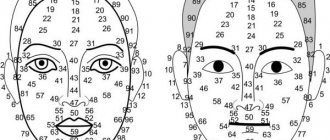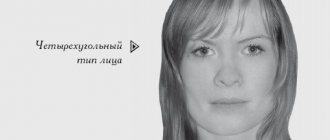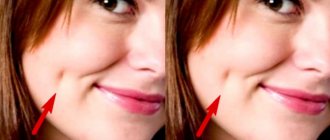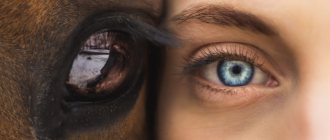Physiognomy is the science of determining a person’s character, habits, and state of health based on a person’s facial features.
Despite the fact that the first mention of this term can be attributed to ancient times, at the present stage researchers find it difficult to say with certainty whether this teaching is a science.
Physiognomy
Many people are quite skeptical about physiognomy and the data that can be obtained as a result of analyzing human facial features.
Every exact science is based on approximation.
BERTRAN RUSSELL
Goals of physiognomy
Physiognomy determines the type of character, psychological qualities and level of health of a person only by his facial features.
This teaching originates in ancient eras, and received intensive development in the Middle Ages, when schools began to be created for a detailed study of facial features and their connection with the character and destiny of a person. However, physiognomy has never been recognized as a science, despite the efforts of some scientists (in particular, Charles Darwin) to prove it.
In any case, knowledge of the basics of physiognomy in our time greatly helps people in such creative professions as actors, directors, artists, and sculptors. After all, due to the nature of their activities, it is so important for them to trace the connection between facial expressions, emotions, thoughts and character. This knowledge is also used by psychologists, politicians, detectives, sales managers and many others.
Many people resort to studying appearance in order to draw conclusions about a person’s inner world. By observing the behavior of individuals, people gradually accumulated the necessary knowledge, which was passed on from one generation to another.
For a long time, people intuitively understood by facial movements what the true intentions and motives of the interlocutor’s behavior were. The human brain is programmed to instantly analyze the received picture, so the attitude towards others is formed almost immediately, even on a subconscious level. Confirmation of this fact can be found not only in scientific treatises, but also in various literary sources.
Information about facial features is used in their practice by fortune tellers, healers, shamans and other representatives of the occult sciences.
Definition of the concept
The name is derived from two Greek words: physis, which means “nature,” and gnomon, which translates as “thought,” “the ability to know.” Physiognomy is a science that determines personality type, character and health characteristics by analyzing the physiological characteristics of the face. It is sometimes called the science of the face.
Ancient China is considered the birthplace of this trend. Then physiognomy came to Ancient Greece, and then spread throughout the East. In Eastern practices, physiognomy was considered as a branch of medicine. The first mentions of the physiognomy we are talking about today are found in the 6th century. BC. And the first person to use the concept of “physiognomy” is considered to be Hippocrates.
Interesting! There is still no single definition and terminological apparatus of physiognomy; it is impossible to name the pioneer of the direction. This makes some people even more doubtful about the validity and justification of this method of studying personality.
Physiognomy at the present stage of development
Initially, physiognomists studied the features of the entire human body, but now facial features have become the focus of researchers.
In the field of view of researchers only congenital features of appearance:
- Shape, size, location of facial features
- Birthmarks
- Color of the skin
- The presence of various kinds of bulges and dents
- Wrinkle lines
- Scars
Convinced adherents of physiognomy believe that by learning to understand what information is embedded in facial features, you can learn a lot of new and useful information.
Ideological, emotional, original
Woody Allen, photo: Getty Images
Highlights: High midface + high eyebrows + heavy lower jaw.
Dreamer and logician rolled into one. A heavy jaw indicates good leadership qualities. This person is capable of leading. Able to achieve goals. Capable. It is interesting that he always acts rationally, but not everyone understands the logic. It's not easy with him in the family. To save your marriage with him, you just need to love him and not try to understand.
Physiognomic analysis
Physiognomic analysis is used in cases where it is necessary to quickly form a correct impression about a practically unknown person (for example, at an interview or at a first meeting).
The main advantage of this method is that the interlocutor will not even know that he is the object of study for you. This means that you will be able to find out information that is valuable to you, while maintaining complete confidentiality.
Brutal, practical, emotional
Ashton Kutcher, photo: Getty Images
Highlights: high jaw + voluminous chin + low, bushy eyebrows.
Women need to be careful with him. Typical traitor. Why do such people often deceive their wives? He is straightforward, but wants to compromise with his desires. Sometimes he acts under the influence of emotions, and sometimes under the influence of logic. It contains two behavioral strategies (this is typical for people with cleft chins). The hemispheres of the brain do not work synchronously in terms of active actions. For such men, the most important thing in cheating is sex.
Facial zones in physiognomy
In physiognomy, there are 3 zones of the face (from top to bottom):
- intellectual;
- emotional;
- vital.
Intelligent face zone
Located in the upper part of the face, it includes the forehead, eyes and eyebrows. Often the size of the forehead depends on the development of a person’s intelligence. But judging how smart a person is based only on the size of his forehead, one can be very mistaken. After all, it happens that, having by nature powerful potential and internal reserves for the development of intelligence, a person does not use them and stands still. There are also cases when in one area an individual reaches heights and is recognized as very smart, but in another he is an absolute amateur.
Furrows on the forehead can tell about a person’s closeness and tendency to constant reflection, and vertical wrinkles above the bridge of the nose indicate the need to often focus on something.
As for the eyes, they are one of the most important objects of analysis in physiognomy. You can read the direction and speed of current thoughts in your eyes. Sparkling, animated eyes indicate that their owner is currently filled with inspiration and is passionate about something. A dull look speaks of despondency, a sad mood and, possibly, depression.
The number of wrinkles in the corners of the eyes indicates the degree of development of a sense of humor, kindness and kindness. Small arches above the eyes will tell about a perceptive and attentive person.
Scientists have proven that there is a connection between the direction of gaze and mental representations of external images, sounds and taste.
Emotional area of the face
It can tell about the depth of soul and sensitivity of an individual. This area includes the nose, mouth, cheeks and cheekbones. If you carefully watch the nose of a person in an excited state, you will notice that the wings of the nose swell, and in a person experiencing disdain and hostility towards something, the nose wrinkles.
As for the lips, their bend necessarily reveals the current emotion (irritation, anger, sadness, resentment, grin, etc.), no matter how hard a person tries to hide it. After all, at the very first moment of the appearance of an emotion, it is reflected on the lips, even if their owner has excellent self-control. If a person bites his lips, then he is in a state of concentration or in a critical situation that requires an immediate solution.
Vital zone of the face
Responsible for satisfying instincts. This zone includes the chin, which can indicate the degree of development of a person’s volitional qualities. Accordingly, a strong, strong-willed person who often has to defend his opinion and life positions has a developed chin.
Moreover, it is precisely at such moments that the chin moves forward, and the muscles of the lower zone of the face actively work. A person with an overdeveloped chin and a square jaw usually goes straight to his goal, without thinking about the consequences and about the people around him. Conversely, a small, weakly defined chin indicates that its owner will easily retreat from achieving the goal if he encounters the first barrier on the way.
What does the shape of the forehead, eyebrows, nose, eyes, ears, mouth mean?
The meaning of forehead height and shape
High - Intellectual. Tall and wide (1) - Characteristic of a philosopher. Tall and narrow - Analytical. Low (2) - Practical, direct, immediate. Convex - Observant, executive. Direct (3) - Cautious, circumspect, good concentration. Concave - Good listener, helpful.
The meaning of eyebrow shape
Thick (4) - Impressive, rough, direct. Subtle - Refined, nervous. Direct (5) - Alive, active. Curved - Inquisitive, inquisitive. Arc-shaped (“arch”) - Possessing a rich imagination.
Rising Up (b) - Ambitious. Those going down - Submissive, uncomplaining. Widely spaced - Easily adaptable, susceptible to influences. Fused - Full of energy.
Meaning of eye shape
Round - Naive, trusting. Oval - Insight, good nature. Slanted (7) - Secretive, self-indulgent. Wide open (8) - Trust, friendly disposition. With closed eyelids (9) - Intrigue, envy. Narrowed Interest, suspicion. Broad-minded - Self-confident, big-minded.
Closely located - Responsible, narrow-minded. Convex - Well-spoken, resourceful and witty. Deep-set (10) - Speaks slowly, insists on facts. Neither prominent nor deep-set - Persuasive speaker and good listener.
The meaning of nose size and shape
Large - Aggressive, experienced, sophisticated. Small - Quiet, modest, unassuming. Subtle - Nervous, irritable. Broad - Verbose, light-hearted. Long (11) - Caring, restless. Short (12) - Cheerful.
With a high bridge of the nose, with a hump (13) - Energetic, inquisitive. Direct - Balanced, thorough, organized. Short and snub-nosed (14) - Friendly, secretive, hardworking.
The importance of ear size and shape
Large - Intellectual. Small - Having a natural flair, instinctive. Longer than wide (15) - Getting carried away, impractical. Wider than it is long - Very practical. Pointed - Clever, cunning, turns a blind eye to everything.
Large earlobes (16) - Independent, intelligent, energetic. Small lobes - Dependent, lacking initiative. No earlobes (17) - Not responsive, lacks a sense of purpose. Closely adjacent to the head - Plans ahead, economical, thrifty. Ears stick out (18) - Original thinker.
The importance of mouth size and shape
Big - Generous, magnanimous, extravagant. Small - Selfish, stingy. Curved Up (19) - Cheerful. Bent down - Dissatisfied. Big lips (20) - Hedonistic. Thin lips - Low emotionality.
Straight lips - Tendency to self-control. Curved (wavy) lips (22) - Variability. Protruding upper lip Criticality, tendency to exaggerate. Protruding lower lip - Delicate, tactful, pleasant. In profile the lips are equal - limited, assertive, similar.
The importance of chin size and shape
Elongated - Stubbornness. Short - Variability. Pointed (23) - Enthusiasm. Split by a deep line (24) - Egocentrism. Double (24) - Friendly, self-indulgent. Cut - Argumentative, impatient, trivial. Dull (25) - Firm, almost emotionless, with a lively character hidden behind the calmness. Forward - Discreet, determined and stubborn.
Determination of health status by face
A person's face can tell others a lot. Specialists in the field of physiognomy can accurately determine by the condition of the skin and some other features of the face what diseases and ailments its owner has.
Skin on the face
Tight, smooth, even-colored skin indicates that there are no abnormalities in the body. And its premature aging is a sign of metabolic disorders, which may be accompanied by a number of diseases: abnormalities in the gastrointestinal tract or genitourinary system, hormonal imbalance. The reason for premature skin aging may also be that a person consumes very little clean drinking water or does not receive enough minerals and vitamins from food.
Skin color also has diagnostic significance. A yellowish tint may indicate problems with the gallbladder or liver. Pronounced pallor indicates anemia. If brown spots appear on the face, then it is worth checking the functioning of the hormonal system, kidneys, and gall bladder. But spots on the skin can also be the result of improper care. For example, excessive sunbathing, incorrectly selected cosmetics or cosmetic procedures.
If a network of blood vessels appears on the face, then it is worth monitoring the vascular system and checking the pressure. Spider veins on the wings of the nose increase the likelihood of lung diseases.
Oily facial skin, especially in older age, indicates hormonal imbalance or stomach problems. Dry skin most often occurs in those who have digestive disorders. This may also be a sign of a lack of water and vitamins in the body.
A large amount of facial hair in women indicates that you should pay attention to hormones.
Eyes
Swollen or drooping eyelids can be the result of lack of sleep or the fact that a person is often nervous.
A bluish color of the skin around the eyelids is also evidence of lack of sleep. But this flaw also often indicates that a person abuses coffee or has diseases of the kidneys and adrenal glands. It is necessary to check the bladder if the color of the lower eyelid has a brown tint.
Red eyelids, especially with a translucent network of blood vessels, are a sign of problems with the vascular system, sensitivity to weather changes, and, as a result, headaches.
Eyebrows and eyelashes
People with thick eyebrows are considered to have strong immunity. And for women, this is also a sign of excellent functioning of the gonads. Thinning eyebrows (especially if this has not been observed before) are a sign of an imbalance of sex hormones, as well as poor functioning of the thyroid gland. People with sparse eyelashes should be more attentive to the functioning of the genitourinary system.
Lips
Blueness or pallor in the area of the nasolabial triangle or the skin around the lips is a sign of disorders in the cardiovascular system, circulatory problems, lung diseases or anemia. Frequent cracks in the corners of the lips indicate vitamin deficiency (in particular, a lack of B vitamins) or allergies.
If you notice any of these signs, you should not panic. After all, this is not a diagnosis, but just a small hint to what you need to pay special attention to in the functioning of your body.
Second type: king
This type of personality is characterized by remarkable emotionality. The physiognomy of this type of eye is associated with rapid excitability and energetic personality. A representative of this type does not have to complain about low self-esteem. Rather, on the contrary, his self-esteem can sometimes exceed reasonable limits. Therefore, it is natural for him from time to time to show his energy in a destructive way - by suppressing others and imposing his way of thinking on others.
In relationships with people, especially with loved ones, such a person likes to play the role of the central person, demanding a lot of attention. Being an egoist, he rarely considers other people and, as a rule, does not want to notice and recognize in them outstanding inclinations, characteristics or achievements that he himself does not possess. In the classroom or in the work team, he likes to occupy a leading position, dictating to everyone his concepts of how to “should” and how to “correctly.”
These psychological inclinations can make such a person a strong leader (often a dictator), a devoted servant of an idea or person whose dominance he recognizes over himself - a religious doctrine or, for example, a mother.
It is difficult for such a person to maintain relationships as equals, as a partner and an equal participant. Therefore, it is extremely difficult for him to cope with the role of a friend, employee or husband. It is also not easy for him to be a father and educator of children.
Dynamics of facial features with human age
Usually, with the help of the senses, information from the outside world is most actively received by a child under the age of 6 years. Using these organs, the baby tries to use his eyes as much as possible to view the world, his ears to hear, his nose to explore common smells, and his mouth to experience new tastes.
But as one gets used to the world around him, the intensity of feelings decreases; a person no longer needs them so much. Soon it becomes increasingly difficult for him to rebuild his perception in constantly changing situations, and all the emotions he experiences are reflected on his face, which becomes less and less mobile.
A person, having ceased to be a child, is not so interested in everything that happens around him and, over time, withdraws into himself. But this time is different for everyone, that is, the dynamics of facial features flows at different speeds for each individual.
Triangle
0
A triangular face is characterized by a narrow forehead and wide chin. Owners of this face shape are creative, artistic and at the same time sensitive individuals. Never cross their path, they will instantly flare up with rage! Due to their determined and persistent nature, they are successful in life. “Triangles” love to lead people; they are leaders by nature. Famous owners of a triangular face shape: Jennifer Aniston, Geena Davis and Minnie Driver.
How can you tell an optimist from a pessimist by their face?
The face of a pessimist loses its expressiveness and thirst for life. Most often, such people are immersed in thought, avoid communication and are introverts. Pessimists are conservative in many ways and are very afraid of changes in life. Therefore, the senses seem to have gone out, their owner uses them little, is not open to the world, and is not interested in anything new. There are cases when a pessimistic person, having gotten rid of negative thoughts or a depressing illness, seems to spread his wings, his eyes light up again, his face comes to life.
You can meet older people, but this age does not affect the liveliness of their faces. As a rule, these people are optimists and extroverts, they have a burning desire to live and rejoice, and easily perceive the need for some kind of change. Their eyes always sparkle and their face appears young.
Distance between eyes
When compiling a profile of a person based on his face, an engineer-psychologist pays attention to every feature. How far the inner corners of the eyes are from each other is a very important fact. If this distance is no more than the width of a finger, then it is considered that these are close-set eyes.
Likewise, if the distance between them is more than two fingers, then they will be wide-set.
Hypertonicity and hypotonicity of facial expressions
They indicate the condition and excitability of the nervous system.
If a person exhibits hypertonicity of facial expressions (muscle tension) , and even more so, winces and tics, then this may indicate the presence of fears and problems that bother the person. This may only be a temporary phenomenon, but in general such people are sociable and energetic, they are good leaders.
Hypotonia (relaxed facial muscles) , as a rule, indicates a lazy person who lacks the desire to solve problems, he seems to be lacking energy. In the eyes of such people you can often notice apathy, the mouth is slightly open, and the eyes, on the contrary, are slightly closed.
Square
0
A square face shape is characterized by a wide forehead and a pronounced jawline. People with this face shape are literally filled with energy and are very resilient. Thanks to this, they happily take on serious and complex projects. “Squares” have a sharp mind and analytical thinking. They are natural leaders who always remain calm and collected, even in high-pressure situations. For women with this face shape, long hair, especially curled in light waves, is suitable. Famous owners of square faces: Sandra Bullock and Angelina Jolie.
Physiognomy - the queen of nonverbals
A study by scientists once again confirmed the effect of a person’s facial expression on the perception of those around him.
Therefore, it is so important that the interlocutor’s facial expression is interpreted correctly. Otherwise, instead of strengthening contact, aggression and mistrust may arise between the participants in the dialogue. Frown eyebrows and a wrinkled forehead in an attentively listening interlocutor can be regarded as a lack of interest, and even as dissatisfaction (the face may seem critical) and cause a response: defensive or aggressive.
Knowing about this peculiarity of perception, it is important to always remember this and watch your face. During communication, relax his muscles, open his eyes wider (instead of frowning). This expression is interpreted as the interlocutor’s interest in what is happening. You should not close your jaws, it is also better to relax your lips. Tightly pursed lips during a conversation are usually regarded as an attempt at verbal aggression. Forehead muscle tension must be relieved constantly throughout the entire period of communication.
You should not try to look like an interested interlocutor during a conversation. You need to become one! To be interested means to be attentive. What and how does the partner say, what gestures does he use? Careful observation of the speaker's facial expressions and gestures during a conversation will help us understand him better, find out what he really feels and how he feels about certain moments and phenomena.
Considering the fact that about 75% of non-verbal information is transmitted through facial expression, it is necessary to learn not only to correctly read this information, but also to adequately convey emotions ourselves. In order to be understood and better understand others, it is important to maintain your attention and interest in the interlocutor during the communication process.
Stress-resistant, hardworking, reckless
Vlad Topalov, photo: Salynskaya Anna/PhotoXPress.ru
Bright features: thick eyebrows + short middle part of the head + high jaw.
Emotional, not afraid of any problems. Hell of stress resistance. At the same time, not a single task was completed. Always gets the desired result with short solutions. He tries to avoid complex and time-consuming tasks. Takes failures calmly. This is precisely the problem for him. Often makes the same mistakes from which he does not learn. Under the influence of emotions, he makes sharp, categorical decisions. Doesn't stress if he fails. His motto: “Everything in life is worth trying.”
Physiognomy: Let's destroy the myths
Over the centuries-old history of physiognomy, many unproven facts and exaggerations have accumulated.
The most common misconceptions:
- It is mistakenly believed that those with a perfectly symmetrical face always have a happy destiny. Actually this is not true. Research has shown that there are practically no people in the world with absolutely symmetrical halves of the face. Some physiognomists believe that such people have good health, others call this phenomenon a sign of approaching death.
- A vertical wrinkle located in the center of the forehead is a sure sign of poverty. This interpretation is not entirely correct, since this mark indicates an intellectually and creatively gifted person.
- The brow ridges hanging over the eyes and a strongly protruding lower jaw are typical facial features of a criminal; this misconception, thanks to the light hand of criminologist Cesare Lombroso, lasted for quite a long time. But modern physiognomists have completely refuted it.
- The statement that a large skull indicates a person’s talent was found to be erroneous. The researchers concluded that there is no direct relationship between mental ability and talent and the size of the skull.
Killers and maniacs with close and deep-set eyes
Moreover, there is an opinion that deep and close-set eyes indicate criminal tendencies of a person. And this can even be confirmed by historical facts. The face of the notorious serial maniac Andrei Chikatilo fits these parameters like no other. The same can be said about Edward Gein, a necrophiliac murderer who made clothes from women's skin and dishes from human skulls. Their deep and close-set eyes leave a heavy impression. Photos of the maniacs were practically not preserved - people tried to erase any memory of these non-humans.
33-year-old Andres Beringa Breivik from Norway, who killed 77 people, also has close-set small eyes, which are also located quite deep.
And, of course, Adolf Hitler, who unleashed the most terrible war in human history. The obsession with becoming the ruler of the whole world awakened a real monster in him.
Vulnerable, sensitive, persuasive
Jensen Ackles, photo: Getty Images
Highlights: sharp upturned nose + thin bridge of the nose + prominent chin.
The complete opposite of Russell Crowe. You can't trust his words. Everything he says must be divided by 10, or even 20. An excellent speaker, he has a good sense of the situation and people. Convincing. At the same time, he does not strive to deeply analyze desires and goals. Is sensitive to criticism. Vulnerable. For him, grievances are a kind of defense. Hysterical.









